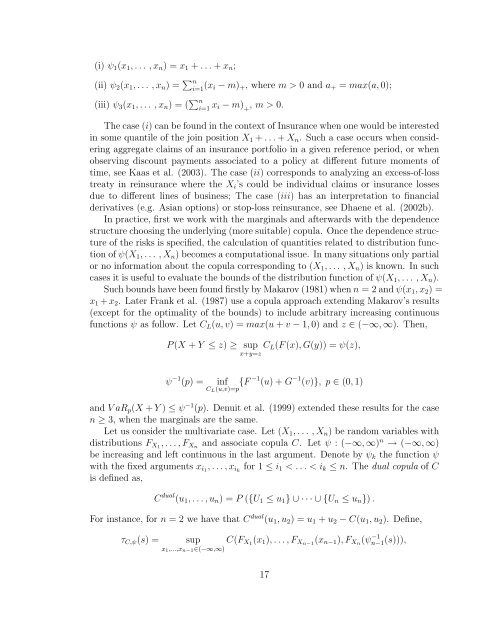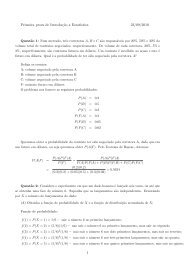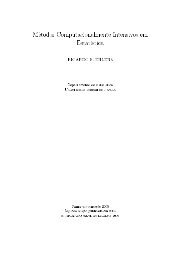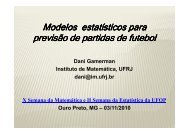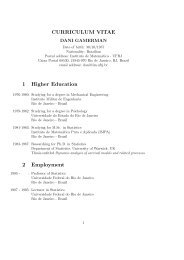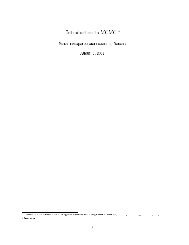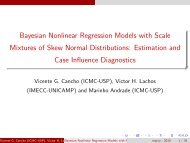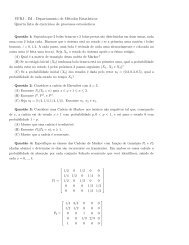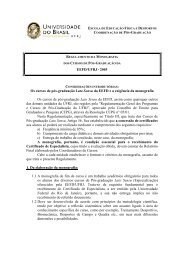Copulas: a Review and Recent Developments (2007)
Copulas: a Review and Recent Developments (2007)
Copulas: a Review and Recent Developments (2007)
You also want an ePaper? Increase the reach of your titles
YUMPU automatically turns print PDFs into web optimized ePapers that Google loves.
(i) à 1 (x 1 ;::: ;x n )=x 1 + :::+ x n ;(ii) à 2 (x 1 ;::: ;x n )= P ni=1 (x i ¡ m) + ,wherem>0<strong>and</strong>a + = max(a; 0);(iii) à 3 (x 1 ;::: ;x n )=( P ni=1 x i ¡ m) +, m>0.The case (i) can be found in the context of Insurance when one would be interestedin some quantile of the join position X 1 + :::+ X n . Such a case occurs when consideringaggregate claims of an insurance portfolio in a given reference period, or whenobserving discount payments associated to a policy at di®erent future moments oftime, see Kaas et al. (2003). The case (ii) corresponds to analyzing an excess-of-losstreaty in reinsurance where the X i 's could be individual claims or insurance lossesdue to di®erent lines of business; The case (iii) has an interpretation to ¯nancialderivatives (e.g. Asian options) or stop-loss reinsurance, see Dhaene et al. (2002b).In practice, ¯rst we work with the marginals <strong>and</strong> afterwards with the dependencestructure choosing the underlying (more suitable) copula. Once the dependence structureof the risks is speci¯ed, the calculation of quantities related to distribution functionof Ã(X 1 ;::: ;X n ) becomes a computational issue. In many situations only partialor no information about the copula corresponding to (X 1 ;::: ;X n )isknown. Insuchcases it is useful to evaluate the bounds of the distribution function of Ã(X 1 ;::: ;X n ).Such bounds have been found ¯rstly by Makarov (1981) when n =2<strong>and</strong>Ã(x 1 ;x 2 )=x 1 + x 2 . Later Frank et al. (1987) use a copula approach extending Makarov's results(except for the optimality of the bounds) to include arbitrary increasing continuousfunctions à as follow. Let C L (u; v) =max(u + v ¡ 1; 0) <strong>and</strong> z 2 (¡1; 1). Then,P (X + Y · z) ¸ sup C L (F (x);G(y)) = Ã(z);x+y=zà ¡1 (p) =inf fF ¡1 (u)+G ¡1 (v)g; p2 (0; 1)C L (u;v)=p<strong>and</strong> VaR p (X + Y ) · à ¡1 (p). Denuit et al. (1999) extended these results for the casen ¸ 3, when the marginals are the same.Let us consider the multivariate case. Let (X 1 ;::: ;X n )ber<strong>and</strong>omvariableswithdistributions F X1 ;:::;F Xn <strong>and</strong> associate copula C. Let à :(¡1; 1) n ! (¡1; 1)be increasing <strong>and</strong> left continuous in the last argument. Denote by à k the function Ãwith the ¯xed arguments x i1 ;:::;x ik for 1 · i 1


